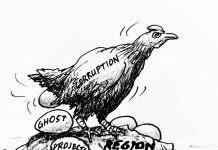Rains came in with such ferocity the last time I saw the swollen creek gulp down a footpath, and then a rice field, then the road. Water roars like a demon, with trees and knee-high mud and scattered things. Still, men continue cutting down trees as if they had nothing else to live for despite all being true.
I don’t have to be a scientist to know that trees hold the earth together. They grasp at the ground with their roots like a grasping hand preventing it from running away when the sky rains and turns the world into a mire. Trees anchor the planet so that the ground doesn’t yield, shattering and pouring down hillsides in landslides that destroy homes and lives. I’ve seen it with my own eyes: homes consumed whole, streets erased out of existence, towns leveled to soggy rags. We curse the rains, but the truth is we’re cursing our own wild hands.
It’s simple to say, “Let’s plant more trees,” and it’s true—we should. But the planting is the simple part. The difficult part is keeping them alive. I have witnessed individuals happily participating in tree-planting rituals, forgetting the saplings as soon as photo opportunities are completed. A neglected tree is equivalent to a dead one, a weak stick poised to wilt under the sun or be trampled by goats. Without attention—without water, without protection from roaming animals and thieving hands—our touted solution turns into a hollow ritual.
And speaking of greedy hands, I’ve lost count of how many newly planted trees have vanished overnight, their absence marked by a pitiful stump. People cut them for fences, firewood, for house posts, thinking that one tree won’t make a difference. But one tree does make a difference. So many “one tree” separate firm land from landslides, managed floods from torrential downpours sweeping everything clean. We cannot continue to chop down young trees faster than we can plant them. That’s trying to fill a dripping bucket-we will never have enough.
I understand the need for those appropriating these trees. For generations, in large parts of rural areas, wood is costly, and getting wood out of the hills has been a family tradition. But times have changed. The rains fall stronger these days, the soil not quite firm, and the risks bigger. What was innocuous—cutting some poles to build a fence—had become a roll-slowly disaster. And yet still, some never wish to learn the link until the flood sweeps through their doorsteps.
We can no longer be shortsighted. We shall plant trees but be their guardian. Schools, barangays, and civic groups should not merely conduct tree planting but tree nourishing. We must have the people’s watch to guard those saplings for the trees won’t be taken nor allowed to wither if the people really wanted them not to. Now imagine if one family took a tree, oh the difference A single mango or narra tree, well maintained, can live for generations, shading roads, stabilizing soil, and keeping disaster at bay.
And let’s be honest: it’s not so much about trees. It’s about our attitude towards nature, towards the future, towards the world we leave behind for our kids. We must cease to think of the environment as a bottomless tank of resources and start thinking of it as a co-conspirator in survival. If we don’t, then we will keep getting caught wading up to our necks in floodwaters, looking for clues as to what went wrong. But in fact, we already know.
The answer is easy, but the task is difficult: plant, defend, and stay. The trees will take care of their side, but will we?




